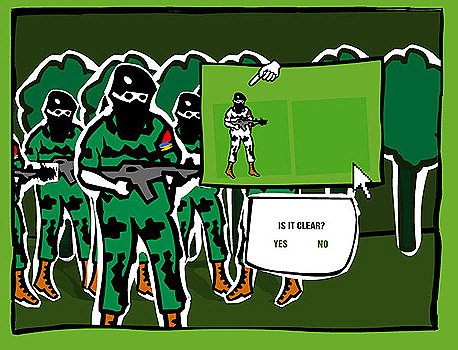Banco de la Republica de Colombia,
Sep 05, 2007 - Mar 05, 2008
Bogota, Colombia
Net Art in Colombia: It's Ugly and Doesn't like the Cursor
by Eduardo Navas
The exhibition Net Art in Colombia: It's Ugly and Doesn't Like the Cursor curated by Juan Devis consists of online projects developed by Colombian artists who approach the Internet as a medium worthy of aesthetic exploration, as well as a tool of dissemination. While some members of online new media communities in different parts of the world might consider the term "Net Art" historically and geographically specific, as it becomes obvious in this exhibition, the term is still at play in online culture with diverse interests, and it need not be considered part of the past. Devis contextualizes the exhibit as an expanding discourse driven by conceptual preoccupations closely tied to political interests. Devis took two years to organize this exhibition for Colombia's Bank of the Republic, being aware that he has not lived in Colombia for many years; he currently resides in Los Angeles. This reality provides him, simultaneously, with critical distance and cultural insiderism that he has utilized to choose critical work which at times is aesthetically pleasing; although, as the title of the exhibition implies, aesthetics is not the primary preoccupation of all the artists. The result is a carefully selected survey that reflects on the politics of Colombian culture. The exhibition, which is inspired by an early net project titled Neme: It's Ugly and Doesn't Like the Cursor (2000) by Santiago Ortiz is divided into six categories: "Free Software art, Open Source and Copy Left"; "Mapping, Crawling and Remixing"; "Networks and Cities"; "Transmissions"; "Uploading Death" and "Play With Me". The themes frame the critical practice of Colombian artists who use new media technology and established critical models to develop work that is relevant to their own reality. For instance, Slow (2006) by Andrés Burbano, Camillo Martinez and Gabriel Zea is an online resource dedicated to support the development of projects with the use of open source software such as Pure Data, Processing, Open Office, and the well-known browser, Firefox. Upon entering the website, one of the most interesting areas for the online user may be the archive of e-mails that have been exchanged by people invested in learning how to use free software; here, one notices the tensions that develop in online communities. While this may be common in various areas of the world, the e-mail archive provides a specific window to a community of South America. Other artists who are part of the exhibition use the Internet as a vehicle for dissemination, specific to national politics. Devis has dedicated the section "networks and cities" to Colombian networked practice. Popular de Lujo (2003) by Juan Esteban Duque, Roxana Martínez, and Esteban Ucrós is an online resource that publishes texts and organizes conferences for Colombian communities, designed to bring together diverse groups that would otherwise remain segregated; in similar fashion Bogowiki (2004) by Alejandro Forero Cuervo is a member driven resource where people living in Bogota can update and create articles relevant to their locality. Much like all other wikis, this one relies on the contribution of the community to develop interesting articles about places throughout the city. The investment in political work is a link between the city and networked culture in the project Radio Fantasmas (2002) by Leonardo González, Alejandro Quintero, and Carlos Osuna. The project consists of scheduled radio broadcasts that the collective organizes in different parts of Colombia promoting the use of emerging technologies, aimed to spark an interest in diverse groups. Their ultimate goal is to travel to various parts of Colombia as well as other countries of South America to introduce radio broadcasting and other emerging media, and in this way be able to promote a critical approach to particular realities. And a critical approach is the p
|











